Charles E W Bean, Diaries, AWM38 3DRL 606/243A/1 - 1916 - 1934 - Part 1
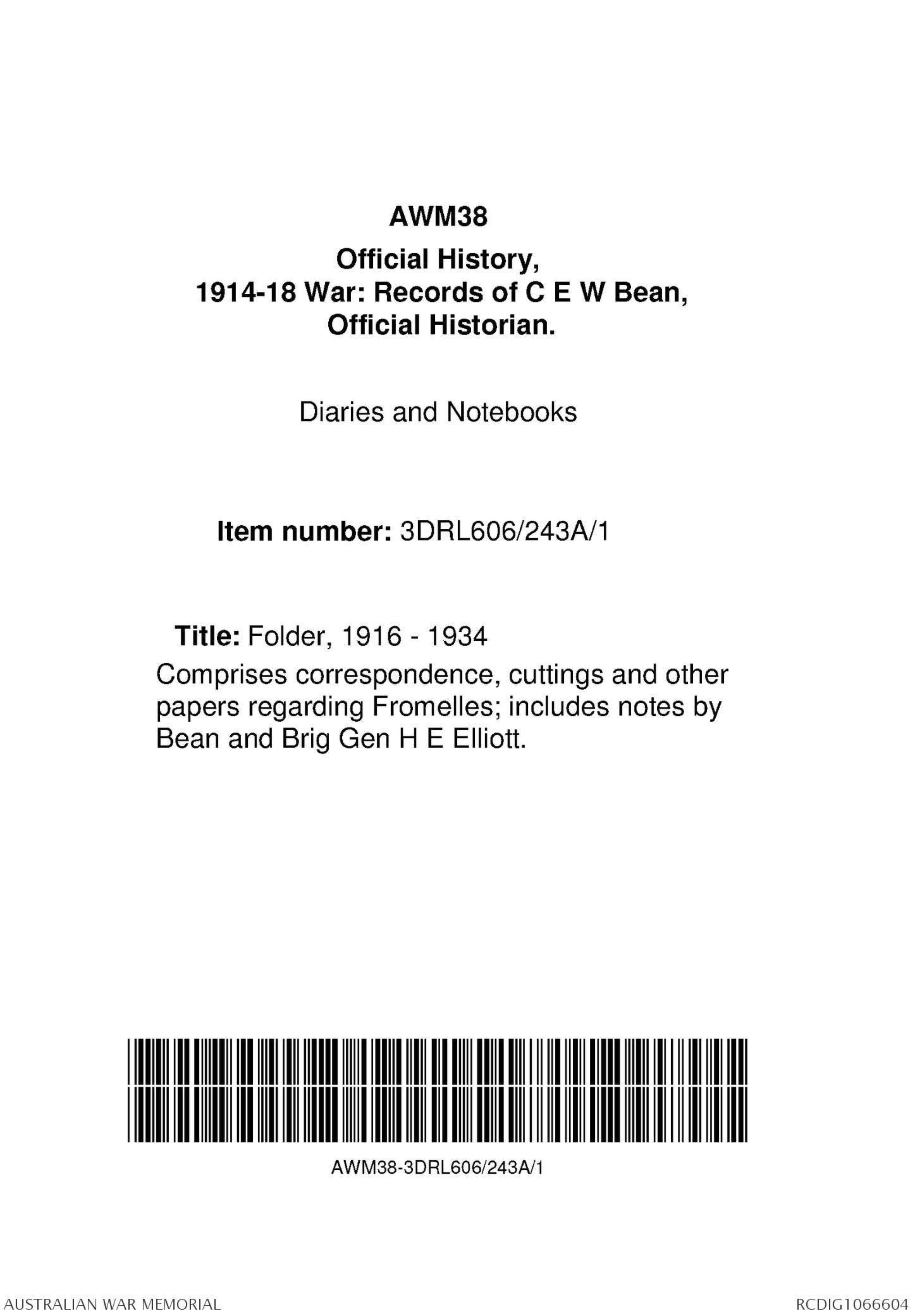
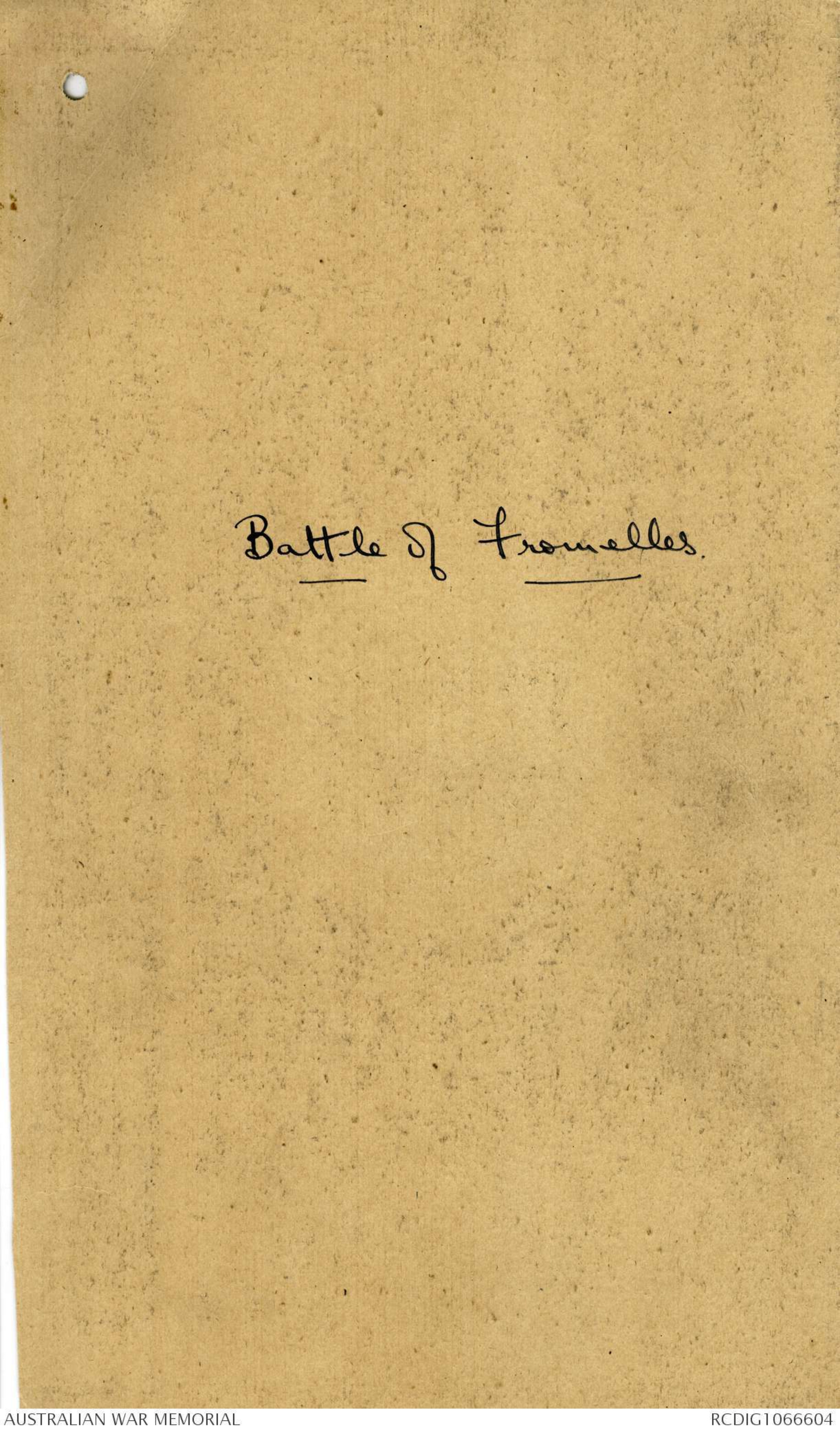
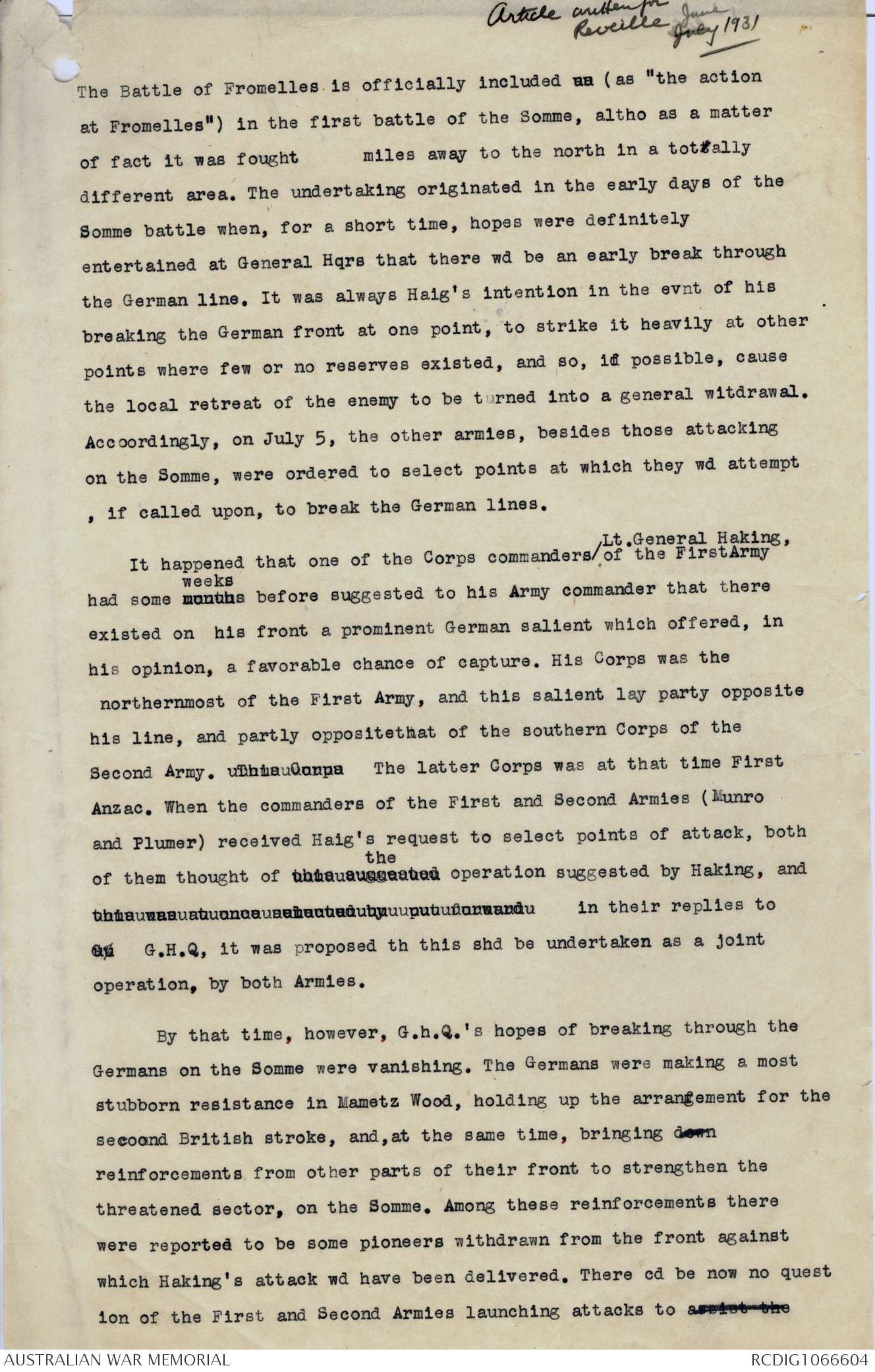
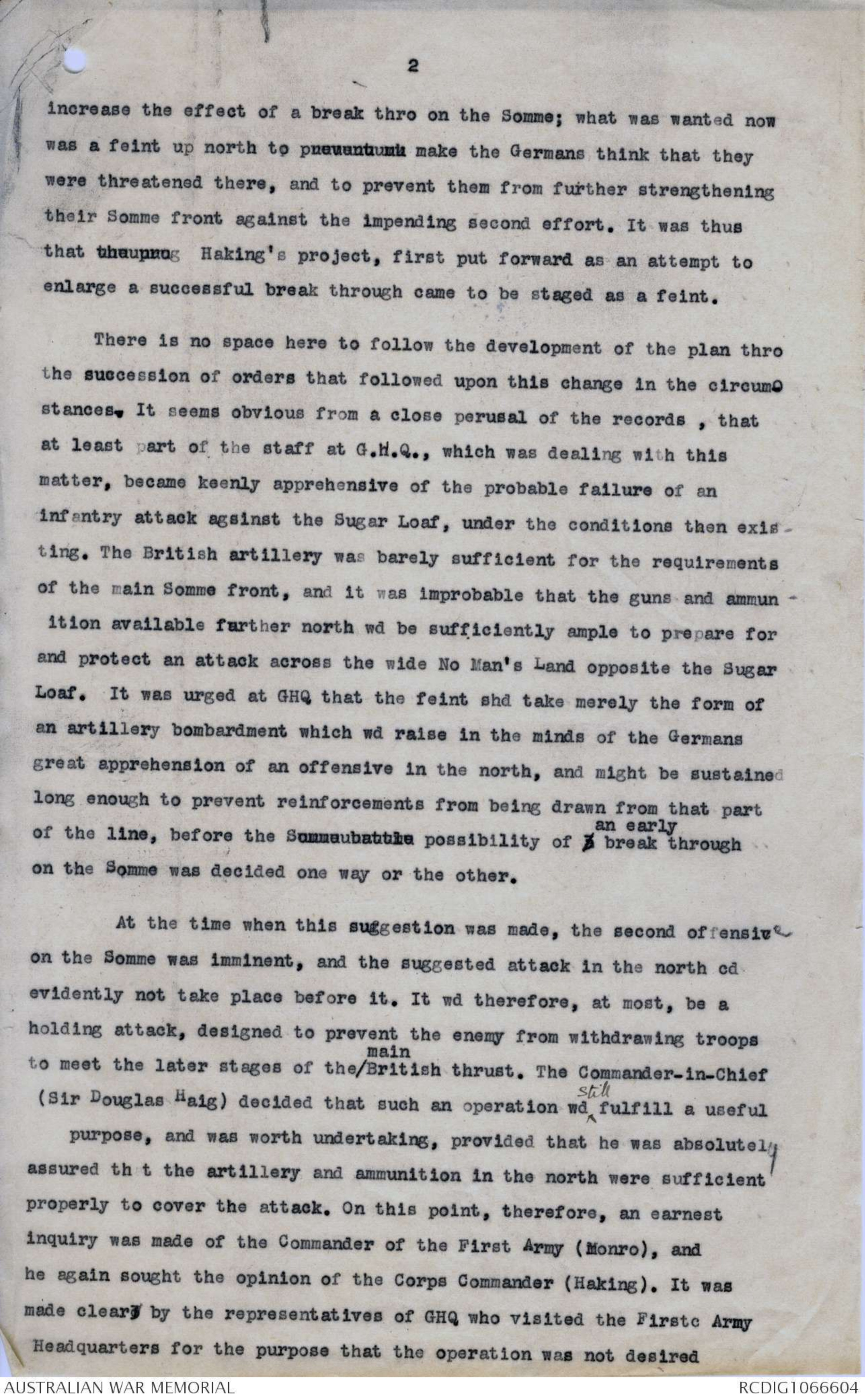
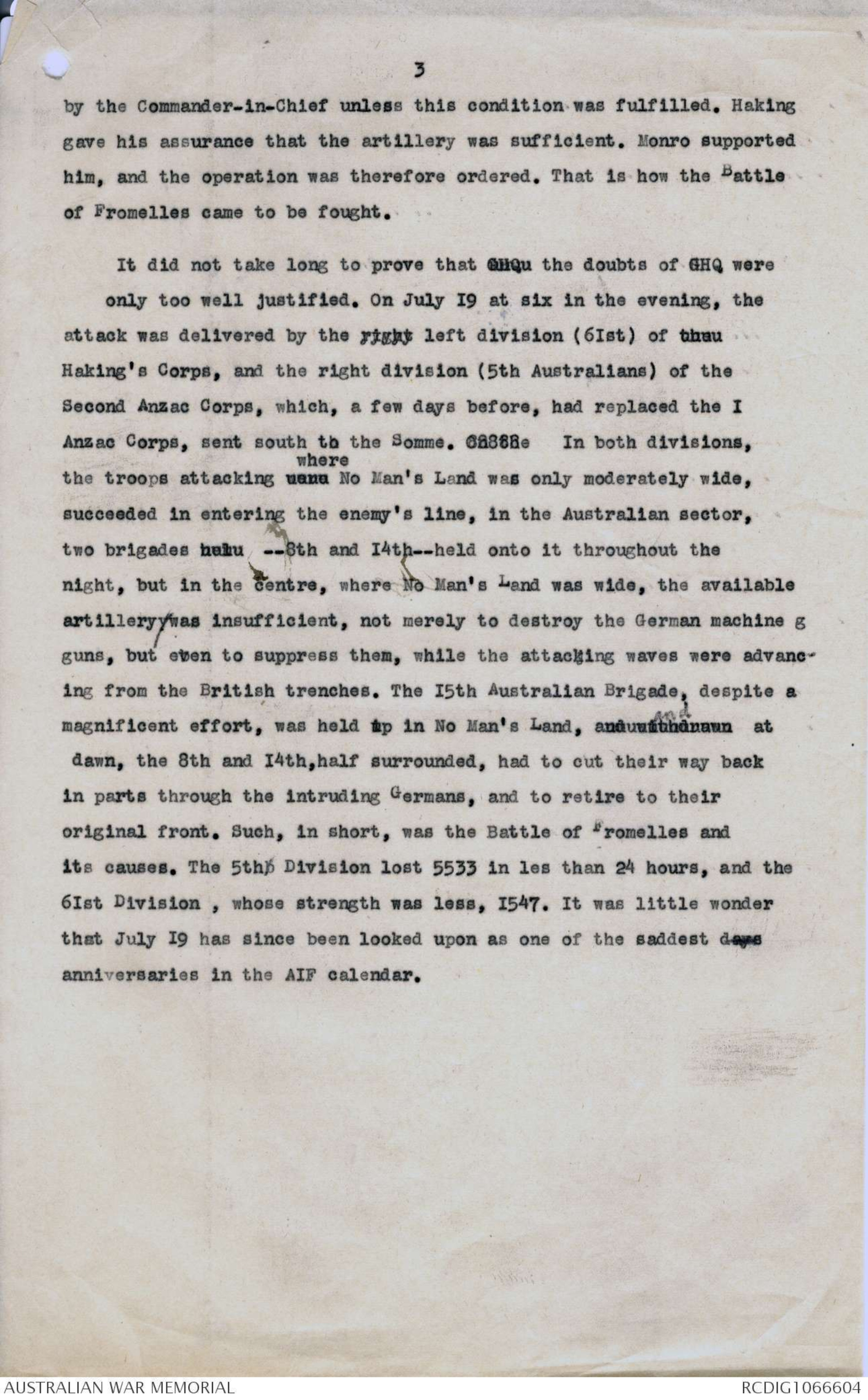
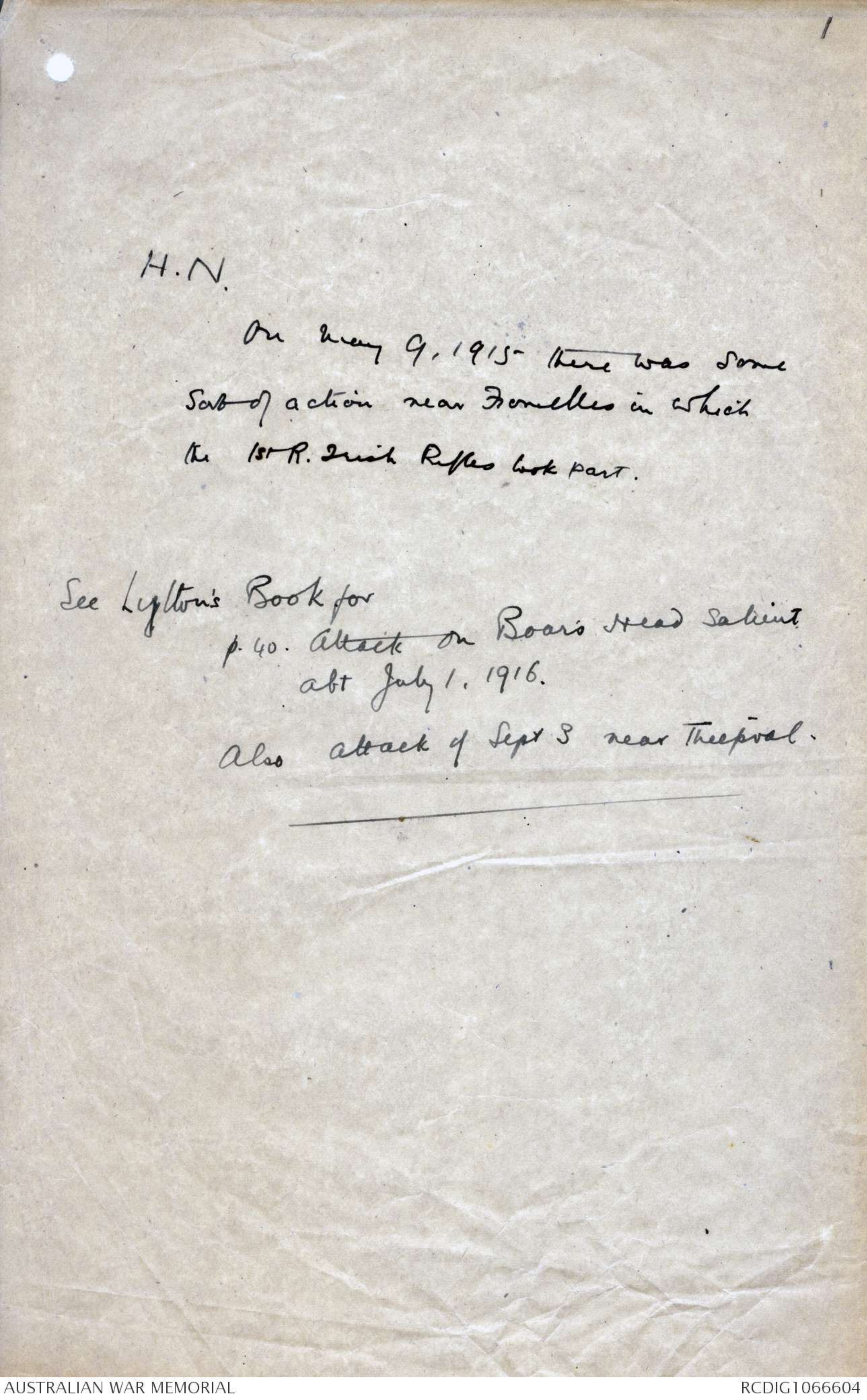
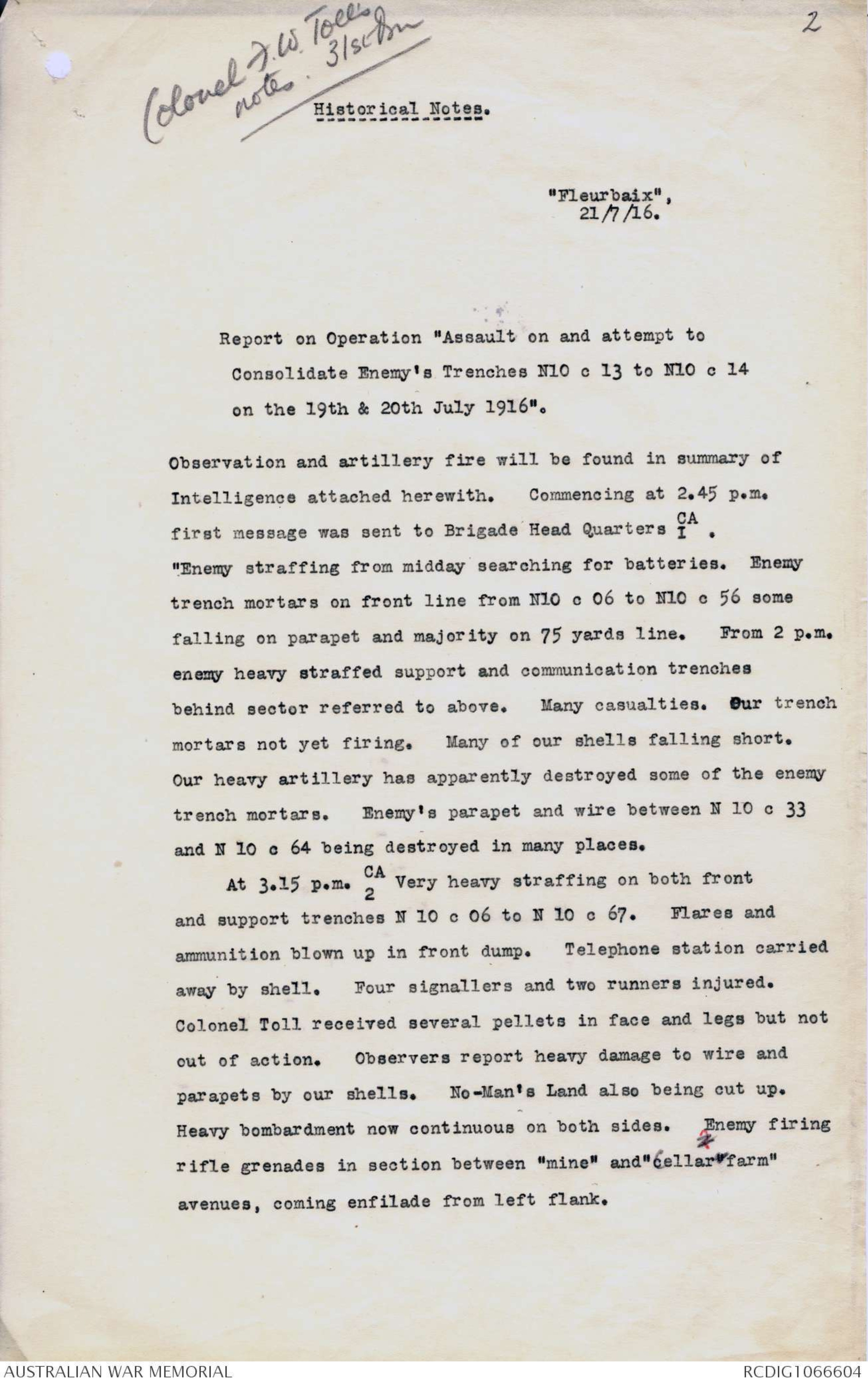
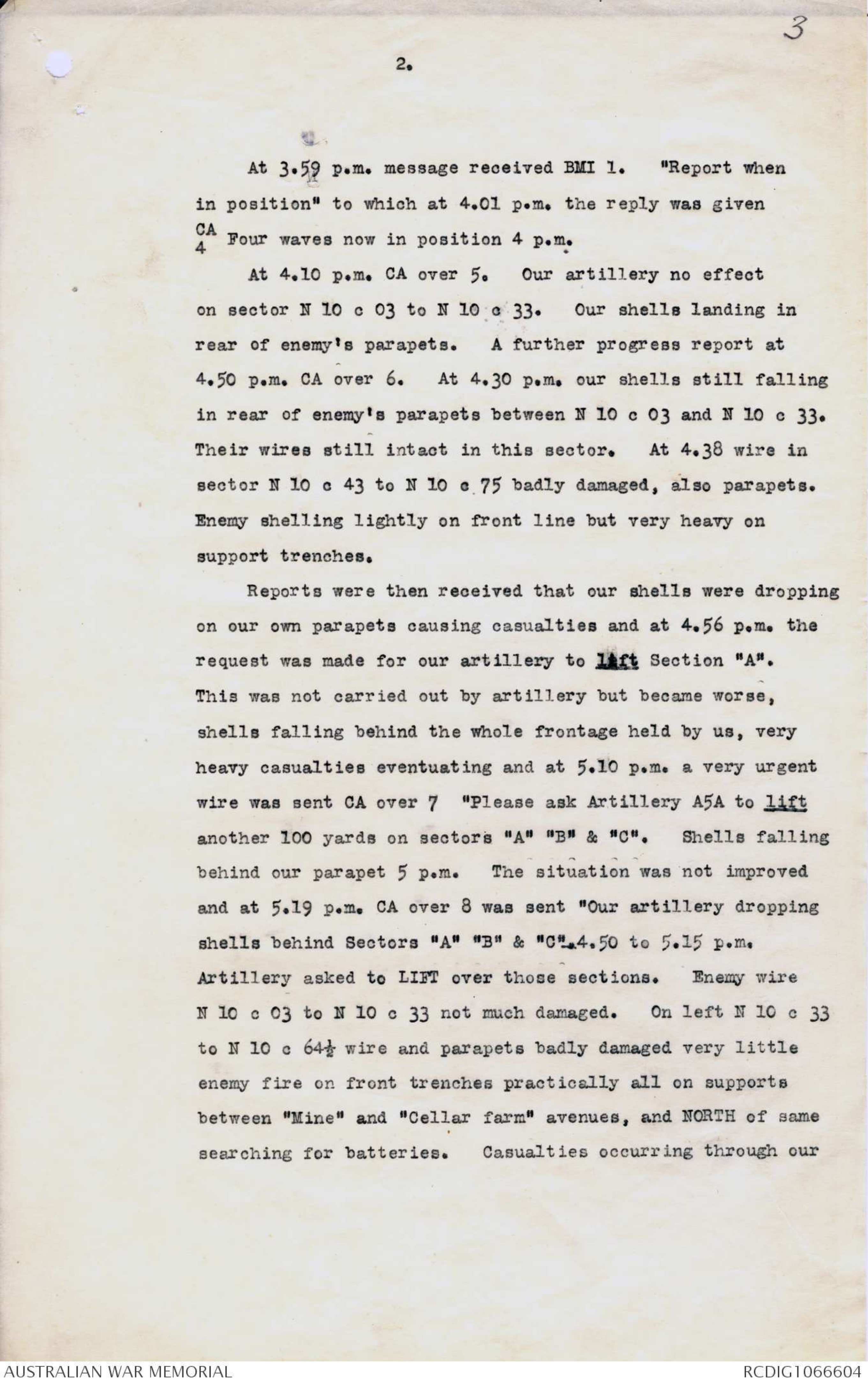
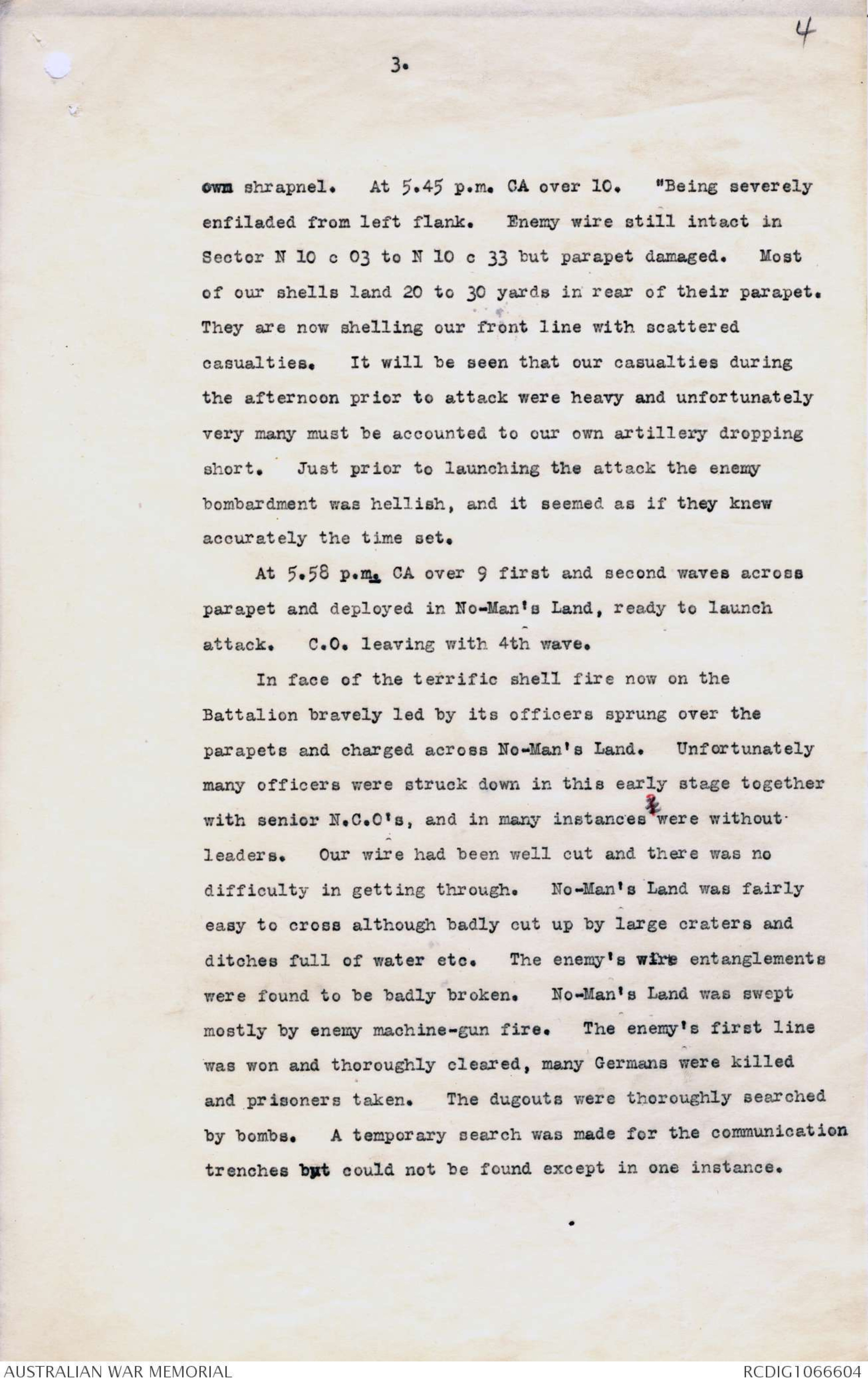
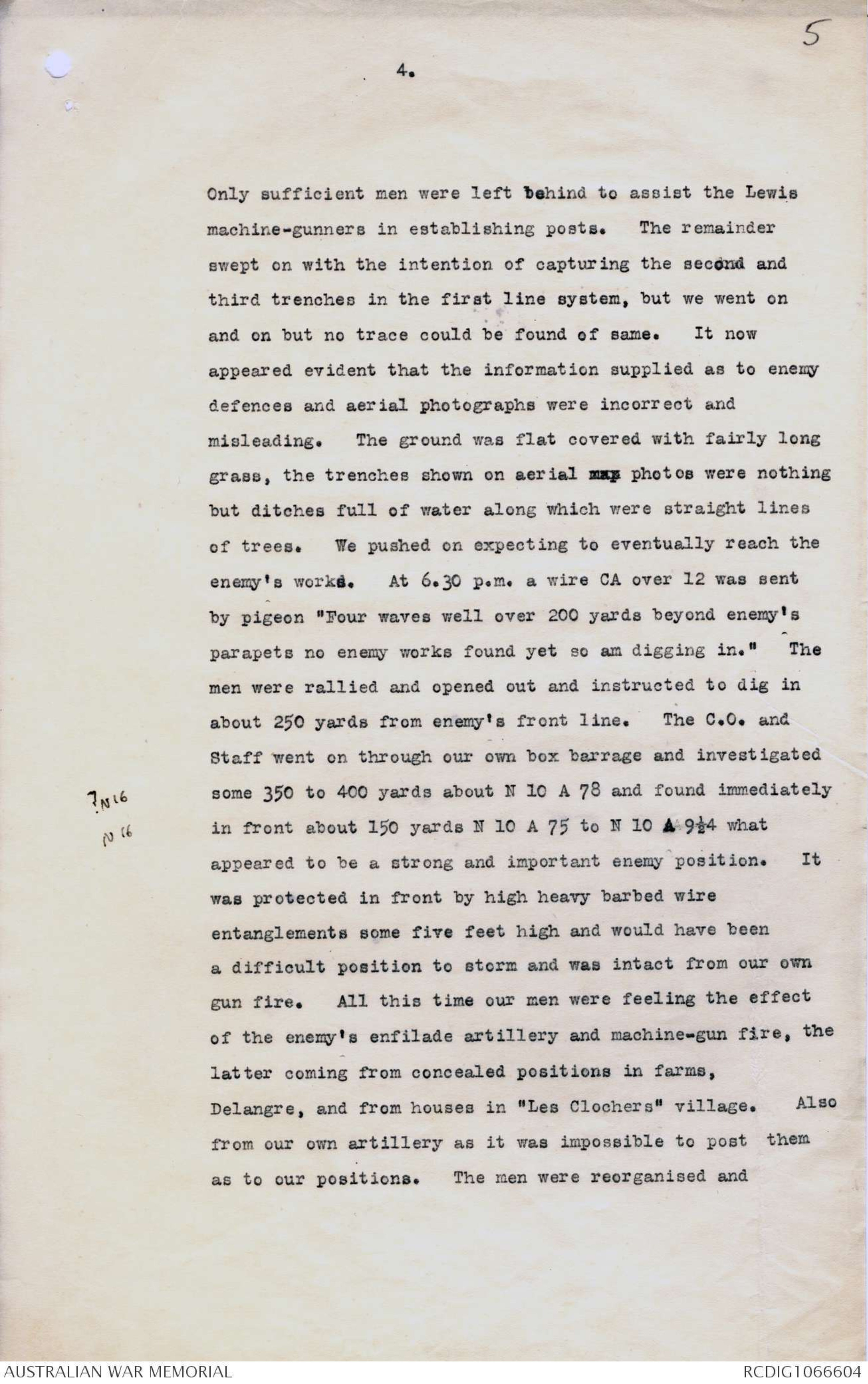
AWM38
Official History,
1914-18 War: Records of C E W Bean,
Official Historian.
Diaries and Notebooks
Item number: 3DRL606/243A/1
Title: Folder, 1916 - 1934
Comprises correspondence, cuttings and other
papers regarding Fromelles; includes notes by
Bean and Brig Gen H E Elliott.
AWM38-3DRL606/243A/1
Battle of Fromelles
[*Article written for
Reveille June July 1931*]
The Battle of Fromelles is officially included as (as "the action
at Fromelles") in the first battle of the Somme, altho as a matter
of fact it was fought miles away to the north in a tottally
different area. The undertaking originated in the early days of the
Somme battle when, for a short time, hopes were definitely
entertained at General Hqrs that there wd be an early break through
the German line. It was always Haig's intention in the evnt of his
breaking the German front at one point, to strike it heavily at other
points where few or no reserves existed, and so, if possible, cause
the local retreat of the enemy to be turned into a general witdrawal.
Accoordingly, on July 5, the other armies, besides those attacking
on the Somme, were ordered to select points at which they wd attempt
, if called upon, to break the German lines.
It happened that one of the Corps commanders ^Lt.General Haking of the FirstArmy
had some months weeks before suggested to his Army commander that there
existed on his front a prominent German salient which offered, in
his opinion, a favorable chance of capture. His Corps was the
northernmost of the First Army, and this salient lay party opposite
his line, and partly oppositethat of the southern Corps of the
Second Army. This Corps The latter Corps was at that time First
Anzac. When the commanders of the First and Second Armies (Munro
and Plumer) received Haig's request to select points of attack, both
of them thought of this suggested the operation suggested by Haking, andthis was at once selected by put forward in their replies touu G.H.Q, it was proposed th this shd be undertaken as a joint
operation, by both Armies.
By that time, however, G.h.Q.'s hopes of breaking through the
Germans on the Somme were vanishing. The Germans were making a most
stubborn resistance in Mametz Wood, holding up the arrangement for the
secoond British stroke, and, at the same time, bringing down
reinforcements from other parts of their front to strengthen the
threatened sector, on the Somme. Among these reinforcements there
were reported to be some pioneers withdrawn from the front against
which Haking's attack wd have been delivered. There cd be now no question
of the First and Second Armies launching attacks to assist the
2
increase the effect of a break thro on the Somme; what was wanted now
was a feint up north to prevent uuu make the Germans think that they
were threatened there, and to prevent them from further strengthening
their Somme front against the impending second effort. It was thus
that the pro Haking's project, first put forward as an attempt to
enlarge a successful break through came to be staged as a feint.
There is no space here to follow the development of the plan thro
the succession of orders that followed upon this change in the cirumstances.
It seems obvious from a close perusal of the records, that
at least part of the staff at G.H.Q., which was dealing with this
matter, became keenly apprehensive of the probable failure of an
infantry attack agsinst the Sugar Loaf, under the conditions then existing.
The British artillery was barely sufficient for the requirements
of the main Somme front, and it was improbable that the guns and ammunition
available further north wd be sufficiently ample to prepare for
and protect an attack across the wide No Man's Land opposite the Sugar
Loaf. It was urged at GHQ that the feint shd take merely the form of
an artillery bombardment which wd raise in the minds of the Germans
great apprehension of an offensive in the north, and might be sustained
long enough to prevent reinforcements from being drawn from that part
of the line, before the Somme battle possibility of B ^an early break through
on the Somme was decided one way or the other.
At the time when this suggestion was made, the second offensive
on the Somme was imminent, and the suggested attack in the north cd
evidently not take place before it. It wd therefore, at most, be a
holding attack, designed to prevent the enemy from withdrawing troops
to meet the later stages of the ^main British thrust. The Commander-in-Chief
(Sir Douglas Haig) decided that such an operation wd ^still fulfill a useful
purpose, and was worth undertaking, provided that he was absolutely
assured th t the artillery and ammunition in the north were sufficient
properly to cover the attack. On this point, therefore, an earnest
inquiry was made of the Commander of the First Army (Monro), and
he again sought the opinion of the Corps Commander (Haking). It was
made clear) by the representatives of GHQ who visited the Firstc Army
Headquarters for the purpose that the operation was not desired
3
by the Commander-in-Chief unless this condition was fulfilled. Haking
gave his assurance that the artillery was sufficient. Monro supported
him, and the operation was therefore ordered. That is how the Battle
of Fromelles came to be fought.
It did not take long to prove that GHQu the doubts of GHQ were
only too well justified. On July I9 at six in the evening, the
attack was delivered by the right left division (6Ist) of theu
Haking's Corps, and the right division (5th Australians) of the
Second Anzac Corps, which, a few days before, had replaced the I
Anzac Corps, sent south to the Somme. C8888e. In both divisions,
the troops attacking uuuu where No Man's Land was only moderately wide,
succeeded in entering the enemy's line, in the Australian sector,
two brigades huku, — 8th and I4th – held onto it throughout the
night, but in the centre, where No Man's Land was wide, the available
artilleryywas insufficient, not merely to destroy the German machine g
guns, but even to suppress them, while the attacking waves were advancing
from the British trenches. The 15th Australian Brigade, despite a
magnificent effort, was held up in No Man's Land, anduatudawn and at
dawn, the 8th and I4th, half surrounded, had to cut their way back
in parts through the intruding Germans, and to retire to their
original front. Such, in short, was the Battle of Fromelles and
its causes. The 5thb Division lost 5533 in les than 24 hours, and the
6Ist Division, whose strength was less, 1547. It was little wonder
that July 19 has since been looked upon as one of the saddest days
anniversaries in the AIF calendar.
1
H.N.
On May 9, 1915 there was some
sort of action near Fromelles in which
the 1st R. Irish Rifles took part.
See Lylton's Book for
p. 40. Attack on Boar's Head Salient
abt July 1, 1916.
Also attack of Sept 3 near Thiepval.
2
[*Colonel F. W. Toll's
notes 31st Bn*]
Historical Notes.
"Fleurbaix",
21/7/16.
Report on Operation "Assault on and attempt to
Consolidate Enemy's Trenches N10 c 13 to N10 c 14
on the 19th & 20th July 1916".
Observation and artillery fire will be found in summary of
Intelligence attached herewith. Commencing at 2.45 p.m.
first message was sent to Brigade Head Quarters CA 1.
"Enemy straffing from midday searching for batteries. Enemy
trench mortars on front line from N10 c 06 to N10 c 56 some
falling on parapet and majority on 75 yards line. From 2 p.m.
enemy heavy straffed support and communication trenches
behind sector referred to above. Many casualties. Our trench
mortars not yet firing. Many of our shells falling short.
Our heavy artillery has apparently destroyed some of the enemy
trench mortars. Enemy's parapet and wire between N 10 c 33
and N 10 c 64 being destroyed in many places.
At 3.15 p.m., CA 2 Very heavy straffing on both front
and support trenches N 10 c 06 to N 10 c 67. Flares and
ammunition blown up in front dump. Telephone station carried
away by shell. Four signallers and two runners injured.
Colonel Toll received several pellets in face and legs but not
out of action. Observers report heavy damage to wire and
parapets by our shells. No-Man's Land also being cut up.
Heavy bombardment now continuous on both sides. Enemy firing
rifle grenades in section between "mine" and"Cellar'farm"
avenues, coming enfilade from left flank.
2. 3
At 3.59 p.m. message received BMI 1. "Report when
in position" to which at 4.01 p.m. the reply was given
CA 4 Four waves now in position 4 p.m.
At 4.10 p.m. CA over 5. Our artillery no effect
on sector N 10 c 03 to N 10 c 33. Our shells landing in
rear of enemy's parapets. A further progress report at
4.50 p.m. CA over 6. At 4.30 p.m. our shells still falling
in rear of enemy's parapets between N 10 c 03 and N 10 c 33.
Their wires still intact in this sector. At 4.38 wire in
sector N 10 c 43 to N 10 c 75 badly damaged, also parapets.
Enemy shelling lightly on front line but very heavy on
support trenches.
Reports were then received that our shells were dropping
on our own parapets causing casualties and at 4.56 p.m. the
request was made for our artillery to lift Section "A".
This was not carried out by artillery but became worse,
shells falling behind the whole frontage held by us, very
heavy casualties eventuating and at 5.10 p.m. a very urgent
wire was sent CA over 7 "Please ask Artillery A5A to lift
another 100 yards on sectors "A" "B" & "C". Shells falling
behind our parapet 5 p.m. The situation was not improved
and at 5.19 p.m. CA over 8 was sent "Our artillery dropping
shells behind Sectors "A" "B" & "C". 4.50 to 5.15 p.m.
Artillery asked to LIFT over those sections. Enemy wire
N 10 c 03 to N 10 c 33 not much damaged. On left N 10 c 33
to N 10 c 64½ wire and parapets badly damaged very little
enemy fire on front trenches practically all on supports
between "Mine" and "Cellar farm" avenues, and NORTH of same
searching for batteries. Casualties occurring through our
3. 4
own shrapnel. At 5.45 p.m. CA over 10. "Being severely
enfiladed from left flank. Enemy wire still intact in
Sector N 10 c 03 to N 10 c 33 but parapet damaged. Most
of our shells land 20 to 30 yards in rear of their parapet.
They are now shelling our front line with scattered
casualties. It will be seen that our casualties during
the afternoon prior to attack were heavy and unfortunately
very many must be accounted to our own artillery dropping
short. Just prior to launching the attack the enemy
bombardment was hellish, and it seemed as if they knew
accurately the time set.
At 5.58 p.m. CA over 9 first and second waves across
parapet and deployed in No-Man's Land, ready to launch
attack. C.O. leaving with 4th wave.
In face of the terrific shell fire now on the
Battalion bravely led by its officers sprung over the
parapets and charged across No-Man's Land. Unfortunately
many officers were struck down in this early stage together
with senior N.C.O's, and in many instances were without
leaders. Our wire had been well cut and there was no
difficulty in getting through. No-Man's Land was fairly
easy to cross although badly cut up by large craters and
ditches full of water etc. The enemy's wire entanglements
were found to be badly broken. No-Man's Land was swept
mostly by enemy machine-gun fire. The enemy's first line
was won and thoroughly cleared, many Germans were killed
and prisoners taken. The dugouts were thoroughly searched
by bombs. A temporary search was made for the communication
trenches but could not be found except in one instance.
4. 5
Only sufficient men were left behind to assist the Lewis
machine-gunners in establishing posts. The remainder
swept on with the intention of capturing the second and
third trenches in the first line system, but we went on
and on but no trace could be found of same. It now
appeared evident that the information supplied as to enemy
defences and aerial photographs were incorrect and
misleading. The ground was flat covered with fairly long
grass, the trenches shown on aerial xxx photos were nothing
but ditches full of water along which were straight lines
of trees. We pushed on expecting to eventually reach the
enemy's works. At 6.30 p.m. a wire CA over 12 was sent
by pigeon "Four waves well over 200 yards beyond enemy's
parapets no enemy works found yet so am digging in." The
men were rallied and opened out and instructed to dig in
about 250 yards from enemy's front line. The C.O. and
Staff went on through our own box barrage and investigated
some 350 to 400 yards about N 10 A 78 and found immediately
[*?N16
N 16*]
in front about 150 yards N 10 A 75 to N 10 A 9½4 what
appeared to be a strong and important enemy position. It
was protected in front by high heavy barbed wire
entanglements some five feet high and would have been
a difficult position to storm and was intact from our own
gun fire. All this time our men were feeling the effect
of the enemy's enfilade artillery and machine-gun fire, the
latter coming from concealed positions in farms,
Delangre, and from houses in "Les Clochers" village. Also
from our own artillery as it was impossible to post them
as to our positions. The men were reorganised and
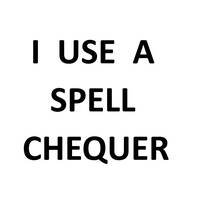 Not Yet Replaced By AI
Not Yet Replaced By AIThis transcription item is now locked to you for editing. To release the lock either Save your changes or Cancel.
This lock will be automatically released after 60 minutes of inactivity.